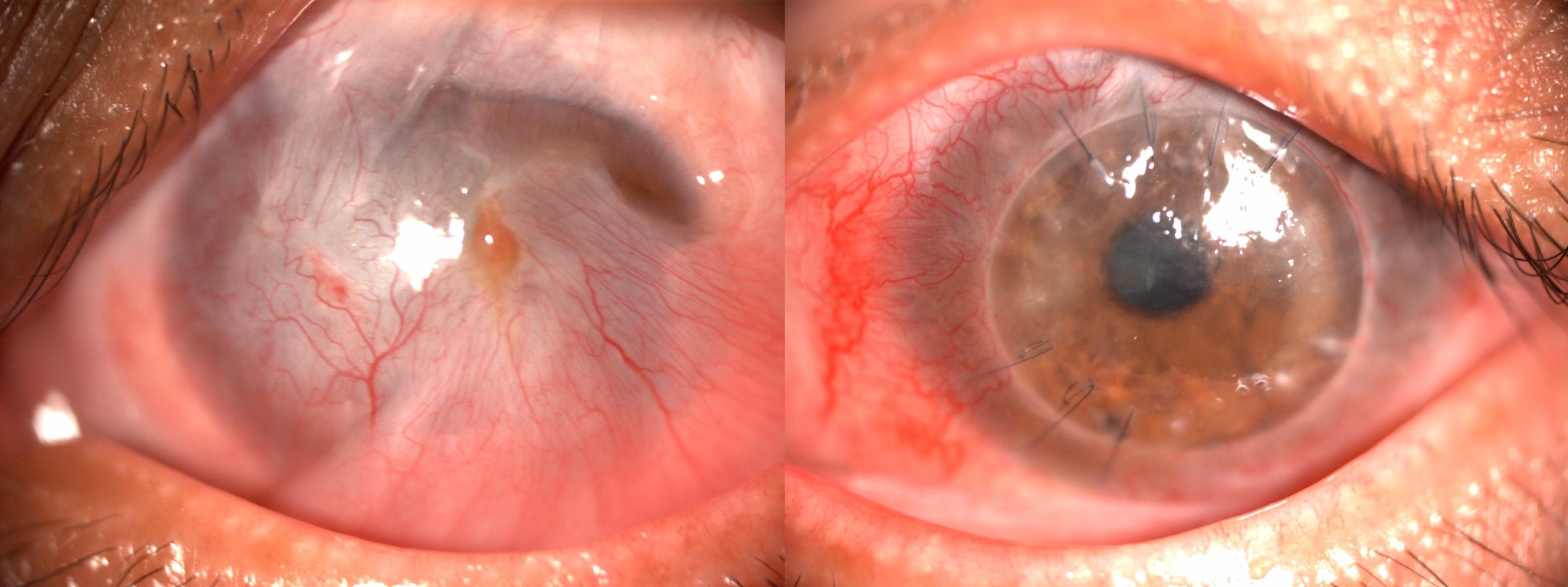Case series of cultivated oral mucosa epithelium transplantation for limbal stem cell failure
experience in Malaysia
Abstract
Purpose: To report a case series of seven eyes (six patients) with severe limbal stem cell failure who underwent cultivated oral mucosa epithelium transplantation (COMET) in preparation for corneal transplant surgery and assess the change in visual acuity postoperatively.
Design: Case series.
Methods: A retrospective analysis of an interventional case series of six patients with severe limbal stem cell deficiency who underwent COMET between 2012 and 2015 was performed. Six eyes had COMET followed by corneal transplant, and one eye had corneal transplant preceding COMET. The change in the visual acuity after operation was evaluated.
Results: A total of six patients with seven eyes were studied. All of them had severe ocular surface disease with limbal stem cell deficiency (LSCD) secondary to chemical injury (five eyes), SJS (one eye), and severe ocular rosacea (one eye). Four eyes had improvements in visual acuity, two of which achieved best corrected visual acuity (BCVA) of 6/12.
Conclusion: The use of COMET helps to optimize the ocular surface in severe LSCD for further corneal transplant surgeries. It has helped to improve the graft uptake and subsequent visual improvement, especially in chronic chemical burn cases.
References
Mannis MJ, Holland EJ, eds. Cornea. 3rd ed. Vol 2. Philadelphia: Elsevier/Mosby; 2011:1713-1720.
2. Ahmad S, Osei-Bempong C, Dana R, Jurkunas U. The culture and transplantation of human limbal
stem cells. Journal of cellular physiology. 2010;225(1):15-19. doi:10.1002/jcp.22251.
3. Sangwan VS. Limbal stem cells in health and disease. Bioscience reports. 2001;21(4):385-405.
4. Shimazaki J, Higa K, Morito F, et al. Factors influencing outcomes in cultivated limbal
epithelial transplantation for chronic cicatricial ocular surface disorders. Am J Ophthalmol.
2007;143(6):945-953. doi:10.1016/j.ajo.2007.03.005.
5. de Araujo AL, Gomes JÃ. Corneal stem cells and tissue engineering: Current advances and future
perspectives. World J Stem Cells. 2015;7(5):806-14. doi:10.4252/wjsc.v7.i5.806.
6. Sangwan VS, Basu S, MacNeil S, Balasubramanian D. Simple limbal epithelial transplantation
(SLET): a novel surgical technique for the treatment of unilateral limbal stem cell deficiency. Br J
Ophthalmol. 2012;96:931-934.
7. Fernandes M, Sangwan VS, Rao SK, et al. Limbal stem cell transplantation. Indian J Ophthalmol.
2004;52(1):5-22.
8. Nishida K, Yamato M, Hayashida Y, et al. Corneal reconstruction with tissue-engineered cell
sheets composed of autologous oral mucosal epithelium. N Eng J Med. 2004;351(12):1187-1196
doi:10.1056/NEJMoa040455
9. Hirayama M, Satake Y, Higa K, Yamaguchi T, Shimazaki J. Transplantation of cultivated oral
mucosal epithelium prepared in fibrin-coated culture dishes. Invest Ophthalmol Vis Sci.
2012;53(3):1602-1609. doi:10.1167/iovs.11-7847.
10. Kinishita S, Nakamura T. Development of cultivated mucosal epithelial sheet transplantation for
ocular surface reconstruction. Artif Organs. 2004;28(1):22-27.
11. Ozdemir O, Tekeli O, Ornek K, Arslanpence A, Yalcindag NF. Limbal autograft and allograft
transplantations in patients with corneal burns. Eye. 2004;18(3):241-248
12. Wagoner, Michael D. Chemical injuries of the eye: current concepts in pathophysiology and
therapy. Surv Ophthalmol. 1997;41(4):275-313.
13. Shimazaki J, Aiba M, Goto E, Kato N, Shimmura S, Tsubota K. Transplantation of human limbal
epithelium cultivated on amniotic membrane for the treatment of severe ocular surface
disorders. Ophthalmology. 2002;109:1285-1290.
14. Samson CM, Nduaguba C, Baltatzis S, Foster CS. Limbal stem cell transplantation in chronic
inflammatory eye disease. Ophthalmology. 2002;109:862-868
15. Tsubota K, Satake Y, Kaido M, et al. Treatment of severe ocular-surface disorders with corneal
epithelial stem-cell transplantation. N Engl J Med. 1999;340:1697-1703.

Copyright (c) 2018 Asian Journal of Ophthalmology

This work is licensed under a Creative Commons Attribution 4.0 International License.
Authors who publish with this journal agree to the following terms:
- Authors retain copyright and grant the journal right of first publication, with the work twelve (12) months after publication simultaneously licensed under a Creative Commons Attribution License that allows others to share the work with an acknowledgement of the work's authorship and initial publication in this journal.
- Authors are able to enter into separate, additional contractual arrangements for the non-exclusive distribution of the journal's published version of the work (e.g., post it to an institutional repository or publish it in a book), with an acknowledgement of its initial publication in this journal.
- Authors are permitted and encouraged to post their work online (e.g., in institutional repositories or on their website) prior to and during the submission process, as it can lead to productive exchanges, as well as earlier and greater citation of published work (See The Effect of Open Access).


